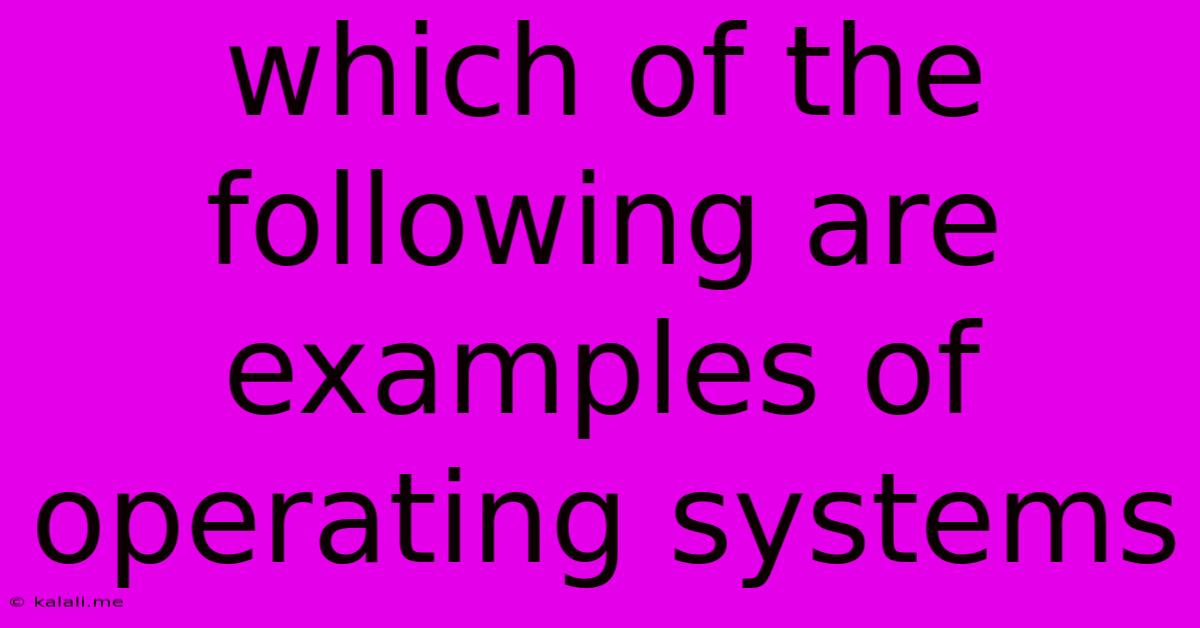Which Of The Following Are Examples Of Operating Systems
Kalali
Jun 13, 2025 · 3 min read

Table of Contents
Which of the Following Are Examples of Operating Systems? A Comprehensive Guide
Operating systems (OS) are the fundamental software that manages computer hardware and software resources. They act as an intermediary between the user and the computer's hardware, allowing users to interact with applications and devices seamlessly. This article will explore what constitutes an operating system and identify examples from a given list (which you will need to provide). Understanding the core functions of an OS is crucial to identifying them accurately.
What Defines an Operating System?
Before we delve into examples, let's establish the key characteristics of an operating system:
- Resource Management: An OS manages all computer resources, including the CPU, memory (RAM), storage devices (hard drives, SSDs), and peripherals (printers, keyboards, mice). It allocates these resources efficiently to running applications.
- Process Management: The OS handles the execution of programs (processes), scheduling their access to the CPU and other resources. It manages the creation, execution, and termination of processes.
- File System Management: The OS organizes and manages files and directories on storage devices, providing a structured way to access and manipulate data.
- User Interface (UI): The OS provides a user interface, which can be either a command-line interface (CLI) or a graphical user interface (GUI), allowing users to interact with the computer.
- Security: The OS implements security measures to protect the system from unauthorized access and malicious software. This includes user authentication, access control, and protection against viruses and malware.
- Hardware Abstraction: The OS acts as an abstraction layer, hiding the complexities of the hardware from applications. This allows applications to run on different hardware platforms without modification.
Identifying Operating Systems: A Case Study
To effectively identify operating systems, let's analyze a hypothetical list. Please provide your list of potential operating systems and applications, and I will analyze each item to determine whether it's an OS or not, explaining my reasoning for each choice. My analysis will consider the core functions outlined above. For example, a simple "yes" or "no" isn't sufficient; I will explain why an item is or is not an operating system.
(Insert your list of items here. For example: Windows 10, Microsoft Word, macOS, Android, Chrome Browser, Linux, iOS, Adobe Photoshop, etc.)
Common Operating System Families:
While waiting for your list, let's briefly touch upon some prominent operating system families:
- Windows: A widely used proprietary OS developed by Microsoft, known for its GUI and vast software compatibility.
- macOS: Apple's proprietary OS for its Macintosh computers, renowned for its user-friendly interface and integration with Apple's ecosystem.
- Linux: A family of open-source Unix-like operating systems known for its flexibility, stability, and widespread use in servers and embedded systems. Many popular distributions exist, such as Ubuntu, Fedora, and Debian.
- Android: A mobile OS based on the Linux kernel, used in most Android smartphones and tablets.
- iOS: Apple's mobile OS for iPhones, iPads, and iPod Touches, known for its simplicity and security.
Once you provide the list of items, I will provide a detailed analysis of each, explaining why they are or are not examples of operating systems based on the characteristics discussed above. This analysis will help clarify the distinctions between operating systems and other types of software.
Latest Posts
Latest Posts
-
Example Of Open Loop Control System
Jun 14, 2025
-
Which Of The Following Is A Weak Electrolyte
Jun 14, 2025
-
Which Of The Following Statements Are True Regarding Electric Generators
Jun 14, 2025
-
Which Era Is Referred To As The Age Of Mammals
Jun 14, 2025
-
All Of The Following Are Classified As Long Bones Except
Jun 14, 2025
Related Post
Thank you for visiting our website which covers about Which Of The Following Are Examples Of Operating Systems . We hope the information provided has been useful to you. Feel free to contact us if you have any questions or need further assistance. See you next time and don't miss to bookmark.